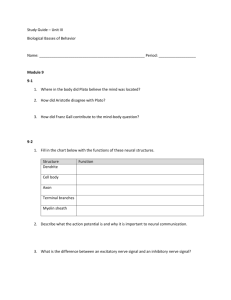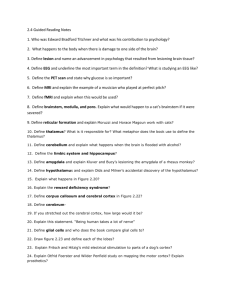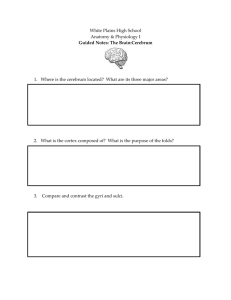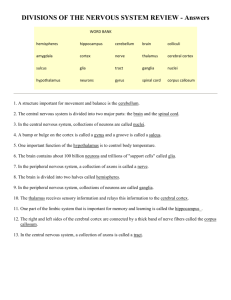Document
advertisement
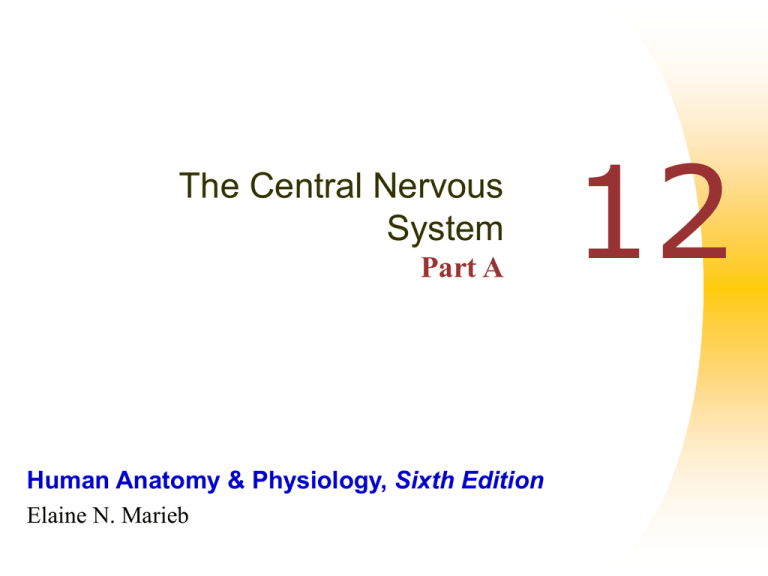
The Central Nervous System Part A Human Anatomy & Physiology, Sixth Edition Elaine N. Marieb 12 Development of Neurons nervous system originates from neural tube & neural crest CNS from neural tube PNS from neural crest cells three-phase process of neural development: Proliferation of neural cells Migration Differentiation of neuroblasts Guiding Axonal Growth Scaffold of glial fibers & ECM Attractants released by target cells Release of NGF by astrocytes Neurotrophins released by other neurons Interactions of repulsive guiding molecules Embryonic Development: Week 1 Fertilization Movement to uterus Implantation Blastocyst formation Blastocyst & Gastrulation Neurulation: Specialization of Ectoderm Figure 28.9a, b Neurulation Figure 28.9c,d Neural Tube & Primary Brain Regions Week 3 Neural Tube & Primary Brain Regions Week 3 Week 4 Neural Tube & Primary Brain Regions LV LV 3rd 4th Week 3 Week 4 Week 5 Brain Development Figure 12.3 Ventricles of the Brain Ventricles are filled with cerebrospinal fluid Fluid moved by ciliary motion of ependymal cells Figure 12.5 Basic Pattern of the Central Nervous System Spinal Cord Core - gray matter – soma Edges - white matter myelinated axon tracts Brain Highly convoluted Cortex & nuclei - areas with mostly neuron soma White mater organized tracts of axons Anatomical Features of the Cerebral Cortex Sulcus (pl sulci) Groove resulting from folding of neural tissue Deep sulci (fissures) divide the hemispheres into lobes Lobe Region of the cerebrum Frontal, parietal, temporal, occipital, & insula Gyrus (pl gyri) Bulging region between shallow sulci Cerebral Cortex Anatomy Cerebral Cortex Gray matter on the surface of the cerebrum Location of motor, sensory & association neuron cell bodies Grey matter sulcus gyrus White matter Cerebral White Matter Myelinated fibers & their tracts Communication between cortex & lower CNS center, & areas of the cortex Commissures Association fibers Projection fibers Functional Areas of the Cerebral Cortex Motor Sensory Cognition Primary Motor Cortex Precentral gyrus Conscious control of voluntary movements Pyramidal cells axons form corticospinal tracts Premotor Cortex Anterior to precentral gyrus Coordinates learned actions Plans of movements Broca’s Area More developed in one hemisphere (usually the left) Directs muscles involved in speech Active as one prepares to speak Frontal Eye Field Controls voluntary eye movement Primary Somatosensory Cortex Located in the postcentral gyrus Receives information from the skin & skeletal muscles Exhibits spatial discrimination Somatosensory Association Cortex Integrates sensory information Comprehensive understanding of the stimulus Visual Areas Primary visual cortex Posterior occipital lobe & in calcarine sulcus Receives visual info from retina Visual association area Surrounds primary visual cortex Interprets visual stimuli Auditory Areas Primary auditory cortex Superior margin of temporal lobe Pitch, rhythm, & loudness info Auditory association area Posterior to the primary auditory cortex Stores memories of sounds & permits perception of sounds Wernicke’s area Integrating sound & speech Olfaction Association & Interpretation Areas Figure 12.8a Proposed Memory Circuits Figure 12.22 Lateralization of Cortical Function Lateralization Unique functions of each hemisphere Left hemisphere language, math, & logic Right hemisphere visual-spatial skills, emotion, & artistic skills Cerebral dominance Hemisphere dominant for language (left)
